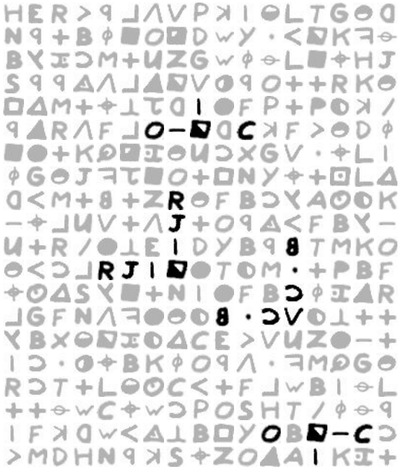These damned pivots and "box corners" are driving me crazy. Especially when viewed in combination with the bizarre "period 19" and "period 15" bigram peaks (and the other unusual biases in bigram counts). (See Jarlve’s and smokie’s extremely productive thread for more about that)

I don’t know if it’s been mentioned before, but notice how each of the pivot patterns appears exactly one column to the left of one of the box corner patterns. Is there some relation?
All I can manage to say about this is:

Lol @ the animation. ![]()
It’s very strange but the problem with observations like this is (while significant) that you can’t easily match them with some sort of scheme/transposition/hypothesis. During your speech one guy mentioned "isologs" and I think the pivots can possibly be classified as such. That they may be non-intuitive patterns that emerged from a scheme.
The bigram repeat period 15, 19 and 29 thing is much more tangible (and also significant because it covers even more of the cipher and can be seen as a more primary observation) and for which we can more easily generate hypotheses. And perhaps fill in the more stranger observations on the way.
I’ve come up with an interesting but rough hypothesis that could explain some of the unusual properties of the "+" symbol and perhaps even more of the cipher in general.
Let’s go through some of the unusual observations of the "+" symbol.
1. It has a count of 24 which is very high.
2. It does not seem to cycle well with other symbols.
3. Against expectations, only one of its positions is a prime number.
4. Two times it can be seen in a box pattern, and more box patterns appear through the cipher.
5. Sum all its positions, divided by 24 will yield 171. In other words, the symbol is perfectly spread around the middle of the cipher.
The following image shows my rough hypothesis (it doesn’t have to be the dimensions or specific transpositions I listed). On the left sits the plaintext of the 408 (340 characters) in a 14 by 25 grid. 1 column is replaced with "+" symbols. Then moving on to the left, the next image shows the same text diagonally transposed. Then the text is casted in a 17 by 20 grid and a similar pattern to that of the 340 comes into existence.

1. The count is explained (but not the motive).
2. Could be explained that the symbol was not substituted more than one homophone.
3, 4 and 5. Could be explained by the mechanics of the transposition.
If this is the case in the 340 then take notice that there may be misalignment (transposition error?) going on (the bigram repeat 15 versus 29 observation which is discussed in: viewtopic.php?f=81&t=2617).
Interesting hypothesis – could the pair of pivots be appearing due to this kind of transformation?
